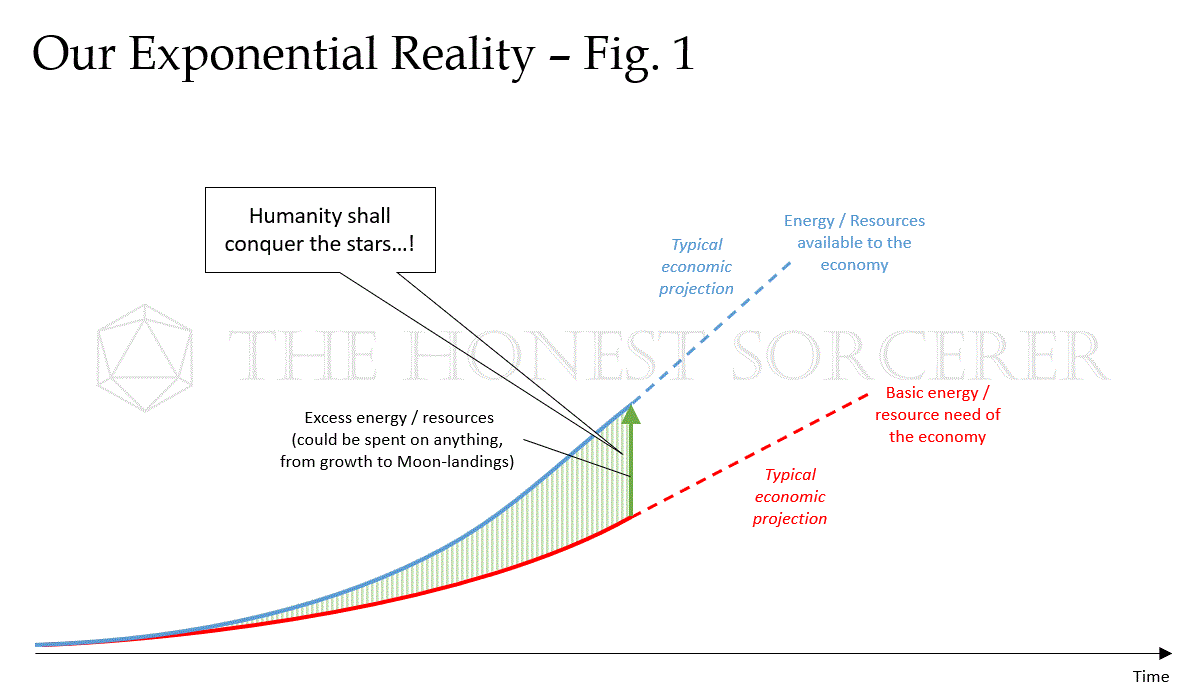In my last two posts, I have highlighted how the depletion of once rich and abundant resources can have a potentially detrimental effect on this civilization. I’ve made the case that a transition to renewables does not stand up to scrutiny, and how a coming peak in copper production could hinder any efforts made at reaching Net Zero. I have concluded that, with peak oil most probably already behind us and with a looming peak in natural gas production, humanity is now facing peak energy — in fact peak everything — in the coming decade or two. What effect will this peak have on our complex societies? Is there a way to forgo this change? This will be the topic of this week’s post.
Increasing complexity was always a hallmark of civilizations. From rural villages to towns and empires, the development of societies always came at a cost of increased complexity. Anthropologist and historian Joseph Tainter has described this process and illustrated it with the story of many past civilizations in his seminal book the Collapse of Complex Societies.
According to the summary of his work, complexity can be recognized by:
- numerous differentiated and specialized social and economic roles (bakers, shoemakers, jewelers, landlords etc.)
- the many mechanisms through which these roles are coordinated (hierarchies)
- the reliance on symbolic and abstract communication (writing, laws, accounting etc.)
- the existence of a class of information producers and analysts who are not involved in primary resource production (clerks, lawyers, engineers etc.)
Following this definition above, the global techno-industrial society is the most complex civilization of all times. We are the pinnacle of social evolution! What could possibly go wrong…?
It’s important to note at this point, that increasing complexity has always been a way to get around “problems” instead of solving them, and not every society lived with this opportunity. In those cultures where it did occur, it came through as a necessity, from which no doubt many have benefited exceedingly. On the other hand, the process of ever increasing complexity has always been a sign of desperation and a major factor behind the fall of empires. Are we an exception to this rule?
According to Tainter, in modern industrial societies the cost of complexity is measured in energy and paid for by fossil fuels. What could illustrate this process more aptly than the green revolution in agriculture?
Let’s start by defining what was the problem we were trying to “solve”. By the middle of 20th century world population was growing exponentially, while the size of the planet apparently did not. We as a species have populated all habitable continents and started to reach, and in some places exceeded, the carrying capacity of the land. Soil fertility was already on the decline: there was an acute shortage of plant nutrients, primarily Nitrogen. Plants did not yield enough food. Something had to be done.
Modern bio-technology came to the rescue. A swathe of technologies were thrown at the apparent problem of “low yields”: chemical fertilizers from the Haber-Bosch process (made available by natural gas), herbicides and pesticides derived from oil, mechanization and long distance transport of produce via diesel fuel, irrigation powered by electricity (ultimately made available by fossil fuels), and new plant varieties producing better yields — relying completely on the previous three inventions to grow… It is needless to emphasize how complex agriculture has become as a result, and how it required ever higher inputs from fossil fuels. All this though has come at the cost of pollution, environmental degradation, species loss and climate change — now threatening the very results the green revolution has achieved.
Observe however, how the root cause of the problem, the underlying predicament of a finite planet’s inability to support unlimited population growth was not solved, but quite the contrary: has only been exacerbated. Now we are facing resource decline in a dangerously destabilized, massively overpopulated world — compared to the number of people the land could’ve support indefinitely without one-time inputs from fossil fuels and mineral phosphorus.
Another prime example, examined in detail last week, is mining. All throughout history we had to deploy ever more complex and energy intensive methods to get the next ton of metal, or next barrel of oil. We had to invent ever more complex machinery and methods — all coming at a cost of increased fossil fuel and electricity use… Thus driving up energy expenditure exponentially in return for an ever lower quality (1) energy carrier or ore. Again, the predicament of running out of cheap, easy to extract resources was not solved at all, but made worse by turning the process of extraction literally ‘a race to the bottom’ —at the cost of destroying the environment.
How long can we continue along these lines? What happens if we cannot? As we have seen, depleting resources demand an exponential increase in our efforts to obtain (the next step requiring substantially more work than the previous) — and thus none of them are exempt to Tainter’s other famous observation: diminishing returns. The problem here is that we humans tend to think in linear terms, while almost everything we do at a global scale have exponential results (2). Which is also true to the negative side-effects of technology: pollution, soil erosion, habitat loss, species extinction. These negative side effects tend to increase disproportionally with any additional use of technology, until the point they start yielding negative returns; i.e.: causing more harm than good.
It is very important to understand here, that no matter how worse the side-effects of technology-use get, turning back is not, and never was an option. The increase in complexity (and thus energy use) is a one way street. The population alive today have to be fed. The machines keeping this civilization functioning (providing electricity, healthcare, shelter, raw materials etc.) have to be powered constantly. Since we’ve built more and more of technology every year, their overall energy requirements only kept growing, despite efficiency gains made throughout the process.
Every increase in complexity has happened with a reason: we had a problem to “solve”. Now, there is no voluntary return to a prior, simpler state without the said problem raising its ugly head again. This is especially true to “problems” (or rather predicaments) related to depletion: you cannot go back mining copper with a pickax and a basket, as those easy to get resources are now long gone… and what remains requires huge, complex, energy hogging machines (not to mention the tons of water and the space needed to place those toxic tail-ponds). Sure, the efficiency of these machines could be improved still somewhat, but the next increase in energy demands (as a result of turning towards lower and lower ore grades) will nullify these results in a matter of years.
As long as we were able to increase energy availability at will there were almost no problems we could not “solve”. Using the metaphor of a rising tide in a harbor full of rocks: as long as water levels were getting higher, we could build ever bigger ships without hitting those pesky rocks. Now that the tide is turning and water levels are getting lower, we will experience problems not seen in a long time… Hidden from plain sight by a massive roll-out of technology and an ever increasing energy use.
There are natural limits to the human endeavor. Predicaments have a tendency of slowly getting worse over time and there is no limit to how gruesome they can become. So far we have “solved” the resulting problems by throwing more and more technologies, and as a result more and more energy at them, but there is a limit to that. As the very predicament of depleting finite resources start to affect energy production (either through fossil fuel depletion or a limit to copper or any other metal’s extraction), our very abilities to handle the problems caused by predicaments will start to wither.
Unless we admit that predicaments like ‘a finite planet’s inability to support unlimited growth or handle unlimited amounts of waste’ have no solutions to them, only outcomes, we will not be able to handle the situation. Only after accepting that there are hard limits has humanity a chance to change course and adopt to a drastically changing landscape. Whether we can do that, is question to be pondered…
Until next time,
B
(If you’ve read so far why not keep scrolling for some bonus content?)
Notes:
(1) Oil brought to surface today is a lot lower quality than back in the heydays. It’s parameters are getting worse when viewed from a global perspective: sulfur content (tar sands), viscosity (shale being to light, Venezuelan oil being to heavy), water cut (as a result of pumping down water to maintain pressure) are all getting worse. Resulting in higher energy use and pollution during refinement. Not to mention extraction itself: just compare the process of fracking with an oil gusher from the early days of the 20th century.
(2) Graphs depicting our situation — bonus content:

A world of abundance, where energy and resource availability grew faster than consumption (around 1950).

The point when we started to realize that growth is not something given, but something that “must be earned” and kept alive… At all costs.

Magical thinking kicks into higher gear — while business as usual goes on unabated.

The uh-oh moment, where growth is no longer possible, and complexity must be shed. Note how the blue energy / resource availability curve follows a Hubbert-curve depicting resource depletion. Population and consumption still keeps growing exponentially, represented by the red curve (a simple exponential chart showing ~3–5% increase/year). After real economic growth is gone, demand growth is fueled by the constant rise in energy demand: generated by “fighting” depletion (mining ever scarcer metals and oil), failing infrastructure, climate change and the rest of the predicaments. This is the state of ultimate overshoot, when not even our artificial (albeit hopelessly temporal) enlargements of a long surpassed natural carrying capacity can support the human enterprise anymore.
Disclaimer: the chart above serves illustrative purposes only, and cannot be considered as an accurate forecast. The aim was to depict one of our biggest predicament: how infinite growth cannot be supported on a finite planet. Although the chart might indicate that we will have fatal crash in the future, in reality I expect to see a zig-zagging red line following the long descent of the blue curve.
Image source: Pexels





